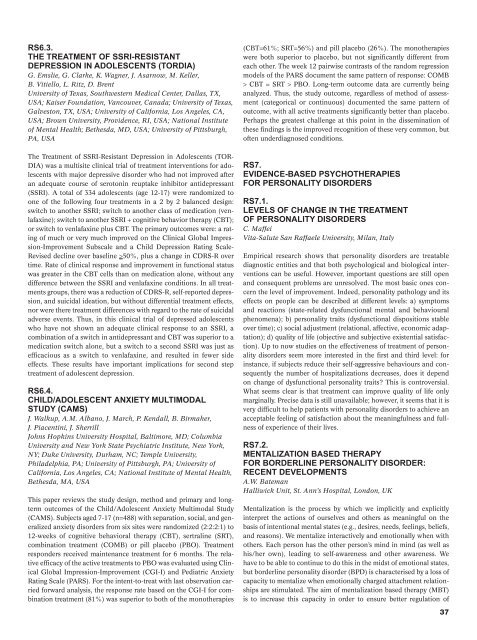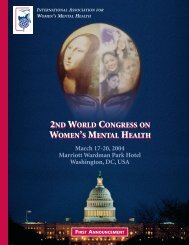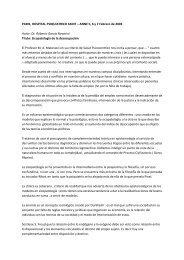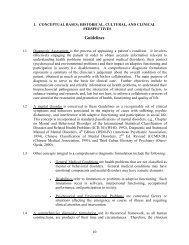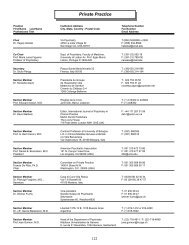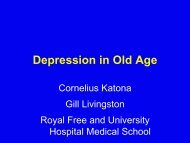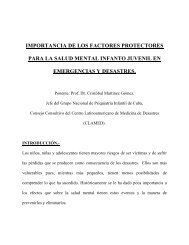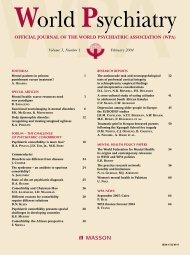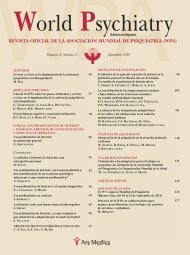ABSTRACTS - World Psychiatric Association
ABSTRACTS - World Psychiatric Association
ABSTRACTS - World Psychiatric Association
You also want an ePaper? Increase the reach of your titles
YUMPU automatically turns print PDFs into web optimized ePapers that Google loves.
RS6.3.<br />
THE TREATMENT OF SSRI-RESISTANT<br />
DEPRESSION IN ADOLESCENTS (TORDIA)<br />
G. Emslie, G. Clarke, K. Wagner, J. Asarnow, M. Keller,<br />
B. Vitiello, L. Ritz, D. Brent<br />
University of Texas, Southwestern Medical Center, Dallas, TX,<br />
USA; Kaiser Foundation, Vancouver, Canada; University of Texas,<br />
Galveston, TX, USA; University of California, Los Angeles, CA,<br />
USA; Brown University, Providence, RI, USA; National Institute<br />
of Mental Health; Bethesda, MD, USA; University of Pittsburgh,<br />
PA, USA<br />
The Treatment of SSRI-Resistant Depression in Adolescents (TOR-<br />
DIA) was a multisite clinical trial of treatment interventions for adolescents<br />
with major depressive disorder who had not improved after<br />
an adequate course of serotonin reuptake inhibitor antidepressant<br />
(SSRI). A total of 334 adolescents (age 12-17) were randomized to<br />
one of the following four treatments in a 2 by 2 balanced design:<br />
switch to another SSRI; switch to another class of medication (venlafaxine);<br />
switch to another SSRI + cognitive behavior therapy (CBT);<br />
or switch to venlafaxine plus CBT. The primary outcomes were: a rating<br />
of much or very much improved on the Clinical Global Impression-Improvement<br />
Subscale and a Child Depression Rating Scale-<br />
Revised decline over baseline >50%, plus a change in CDRS-R over<br />
time. Rate of clinical response and improvement in functional status<br />
was greater in the CBT cells than on medication alone, without any<br />
difference between the SSRI and venlafaxine conditions. In all treatments<br />
groups, there was a reduction of CDRS-R, self-reported depression,<br />
and suicidal ideation, but without differential treatment effects,<br />
nor were there treatment differences with regard to the rate of suicidal<br />
adverse events. Thus, in this clinical trial of depressed adolescents<br />
who have not shown an adequate clinical response to an SSRI, a<br />
combination of a switch in antidepressant and CBT was superior to a<br />
medication switch alone, but a switch to a second SSRI was just as<br />
efficacious as a switch to venlafaxine, and resulted in fewer side<br />
effects. These results have important implications for second step<br />
treatment of adolescent depression.<br />
RS6.4.<br />
CHILD/ADOLESCENT ANXIETY MULTIMODAL<br />
STUDY (CAMS)<br />
J. Walkup, A.M. Albano, J. March, P. Kendall, B. Birmaher,<br />
J. Piacentini, J. Sherrill<br />
Johns Hopkins University Hospital, Baltimore, MD; Columbia<br />
University and New York State <strong>Psychiatric</strong> Institute, New York,<br />
NY; Duke University, Durham, NC; Temple University,<br />
Philadelphia, PA; University of Pittsburgh, PA; University of<br />
California, Los Angeles, CA; National Institute of Mental Health,<br />
Bethesda, MA, USA<br />
This paper reviews the study design, method and primary and longterm<br />
outcomes of the Child/Adolescent Anxiety Multimodal Study<br />
(CAMS). Subjects aged 7-17 (n=488) with separation, social, and generalized<br />
anxiety disorders from six sites were randomized (2:2:2:1) to<br />
12-weeks of cognitive behavioral therapy (CBT), sertraline (SRT),<br />
combination treatment (COMB) or pill placebo (PBO). Treatment<br />
responders received maintenance treatment for 6 months. The relative<br />
efficacy of the active treatments to PBO was evaluated using Clinical<br />
Global Impression-Improvement (CGI-I) and Pediatric Anxiety<br />
Rating Scale (PARS). For the intent-to-treat with last observation carried<br />
forward analysis, the response rate based on the CGI-I for combination<br />
treatment (81%) was superior to both of the monotherapies<br />
(CBT=61%; SRT=56%) and pill placebo (26%). The monotherapies<br />
were both superior to placebo, but not significantly different from<br />
each other. The week 12 pairwise contrasts of the random regression<br />
models of the PARS document the same pattern of response: COMB<br />
> CBT = SRT > PBO. Long-term outcome data are currently being<br />
analyzed. Thus, the study outcome, regardless of method of assessment<br />
(categorical or continuous) documented the same pattern of<br />
outcome, with all active treatments significantly better than placebo.<br />
Perhaps the greatest challenge at this point in the dissemination of<br />
these findings is the improved recognition of these very common, but<br />
often underdiagnosed conditions.<br />
RS7.<br />
EVIDENCE-BASED PSYCHOTHERAPIES<br />
FOR PERSONALITY DISORDERS<br />
RS7.1.<br />
LEVELS OF CHANGE IN THE TREATMENT<br />
OF PERSONALITY DISORDERS<br />
C. Maffei<br />
Vita-Salute San Raffaele University, Milan, Italy<br />
Empirical research shows that personality disorders are treatable<br />
diagnostic entities and that both psychological and biological interventions<br />
can be useful. However, important questions are still open<br />
and consequent problems are unresolved. The most basic ones concern<br />
the level of improvement. Indeed, personality pathology and its<br />
effects on people can be described at different levels: a) symptoms<br />
and reactions (state-related dysfunctional mental and behavioural<br />
phenomena); b) personality traits (dysfunctional dispositions stable<br />
over time); c) social adjustment (relational, affective, economic adaptation);<br />
d) quality of life (objective and subjective existential satisfaction).<br />
Up to now studies on the effectiveness of treatment of personality<br />
disorders seem more interested in the first and third level: for<br />
instance, if subjects reduce their self-aggressive behaviours and consequently<br />
the number of hospitalizations decreases, does it depend<br />
on change of dysfunctional personality traits This is controversial.<br />
What seems clear is that treatment can improve quality of life only<br />
marginally. Precise data is still unavailable; however, it seems that it is<br />
very difficult to help patients with personality disorders to achieve an<br />
acceptable feeling of satisfaction about the meaningfulness and fullness<br />
of experience of their lives.<br />
RS7.2.<br />
MENTALIZATION BASED THERAPY<br />
FOR BORDERLINE PERSONALITY DISORDER:<br />
RECENT DEVELOPMENTS<br />
A.W. Bateman<br />
Halliwick Unit, St. Ann’s Hospital, London, UK<br />
Mentalization is the process by which we implicitly and explicitly<br />
interpret the actions of ourselves and others as meaningful on the<br />
basis of intentional mental states (e.g., desires, needs, feelings, beliefs,<br />
and reasons). We mentalize interactively and emotionally when with<br />
others. Each person has the other person’s mind in mind (as well as<br />
his/her own), leading to self-awareness and other awareness. We<br />
have to be able to continue to do this in the midst of emotional states,<br />
but borderline personality disorder (BPD) is characterised by a loss of<br />
capacity to mentalize when emotionally charged attachment relationships<br />
are stimulated. The aim of mentalization based therapy (MBT)<br />
is to increase this capacity in order to ensure better regulation of<br />
37


